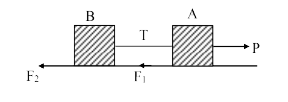If the nuclear force between two protons, two neutrons and between proton and neutron is denoted by Fpp,Fnn and Fpn respectively, then
Fpp≈Fnn≈Fpn
Fpp≠Fnn and Fpp=Fnn
Fpp=Fnn=Fpn
Fpp≠Fnn≠Fpn
The correct Answer is:C
To solve the question regarding the nuclear forces between protons and neutrons, we can analyze the relationships between the forces denoted as Fpp, Fnn, and Fpn.
1. Understanding Nuclear Forces:
- The nuclear force is the force that holds protons and neutrons together in the nucleus of an atom. It is a strong force that acts between nucleons (protons and neutrons).
2. Identifying the Forces:
- Let Fpp be the nuclear force between two protons.
- Let Fnn be the nuclear force between two neutrons.
- Let Fpn be the nuclear force between a proton and a neutron.
3. Comparing the Forces:
- The nuclear force is a short-range force and is approximately the same for all nucleons when they are in close proximity. This means that the strength of the nuclear force does not depend significantly on whether the nucleons are protons or neutrons.
- Therefore, we can state that:
Fpp≈Fnn≈Fpn
4. Conclusion:
- Since the nuclear force is similar between any two nucleons, we conclude that:
Fpp=Fnn=Fpn
- Thus, the correct answer is that all three forces are approximately equal.
Final Answer:
The nuclear forces are equal: Fpp=Fnn=Fpn.
---
- The nuclear force is the force that holds protons and neutrons together in the nucleus of an atom. It is a strong force that acts between nucleons (protons and neutrons).
- Let Fpp be the nuclear force between two protons.
- Let Fnn be the nuclear force between two neutrons.
- Let Fpn be the nuclear force between a proton and a neutron.
- The nuclear force is a short-range force and is approximately the same for all nucleons when they are in close proximity. This means that the strength of the nuclear force does not depend significantly on whether the nucleons are protons or neutrons.
- Therefore, we can state that:
Fpp≈Fnn≈Fpn
- Since the nuclear force is similar between any two nucleons, we conclude that:
Fpp=Fnn=Fpn
- Thus, the correct answer is that all three forces are approximately equal.
The nuclear forces are equal: Fpp=Fnn=Fpn.
Similar Questions
Fpp,FnnandFnp are the nuclear forces between proton - proton , neutron - neutron and neutron - proton respectively . Then relation between them is
View SolutionIn the nucleus of helium if F1isthe≠tforcebetweentwopro→ns,F_2isthe≠tforcebetweentwo≠utronsandF_3 is the net force between a proton and a neutron. Then,
View Solution
Knowledge Check
Assertion:Nuclear force between neutron-neutron, proton-neutron and proton-proton is approximately the same
Reason : The nuclear force does not depend on the electric chargeAIf both assertion and reason are true and reason is the correct explanation of assertion .BIf both assertion and reason are true but reason is not the correct explanation of assertion .CIf assertion is true but reason is false .DIf both assertion and reason are false
Let Fpp,FpnandF∩ denote the magnitudes of the nuclear force by a proton on a proton, by a proton on a neutron and by a neutron on a neutron respectively. When the separation is 1fm,
View SolutionAn element of mass M has Z protons and Nneutrons. Masses of proton and neutron are mpandmn respectively. Choose the correct relation among following options.
View SolutionFor a nucleus to be stable, the correct relation between neutron number N and proton number Z is.
View SolutionFor a nucleus to be stable, the correct relation between neutron number N and proton number Z is.
View SolutionAssertion : Nuclear forces arise from strong coulombic interactions between protons and neutrons
Reason : Nuclear forces are independent of charge of the nucleons
View SolutionCalculate the minimum energy needed to separate a neutron form a nucleus with Z protons and N neutrons in terms of the masses MZ,N,MZ,N−1 and the mass of the neutron.
View SolutionTwo blocks A and B of the same mass are joined by a light string and placed on a horizontal surface. An external horizontal force P acts on A. The tension in the string is T. The forces of static friction acting on A and B are F1 and F2 respectively. The limiting value of F1 and F2 is F0. As P is gradually increased.

View Solution
